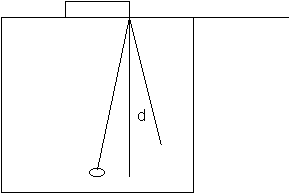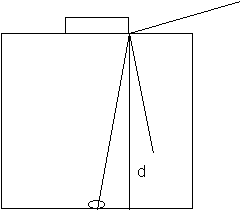| Ch.35 | 7 | 11 | 16 | 17 | 18 | 39 | 41 | 55 | 61 |
| Answers | |||||||||
|
Chapter 35 Summary: Below is a pictorial
summary of the lecture deriving the law of reflection using
Huygens' Principle. We stated that the incident wave front shown strikes
the surface at point A, and that point (A) becomes a point source of
spherical waves according to Huygens. AD= BC, and the 2 right
triangles ADC and CBA share a common side AC. Therefore, the
triangles ADC and CBA are similar and the two angles with the
horizontal are equal :
|
|||||||||
| 7. See fig. 35.30....n1sin°1 =n2sin45. Find °1 . Note: n 1 = 1 and n 2 = value for water....Note °1 >450 | |||||||||
| 11. Click WEB and scroll down to Chapter 35 and click problem 11 to see how this problem is done on the student web site at http://www.harcourtcollege.com/physics/pse/student/guide/... If a problem is labeled "web" in the textbook, as this one is, you can always go to this link and see the solution.....Please bookmark the link for future reference ..... | |||||||||
| 16. d = (2.00 cm/cos°2)sin(30-°2), where °2 is found using snell's law: n1sin°1 = n2sin°2 with °1 = 300, n1 = 1 and n2 = value for glass. See table 35. 1. | |||||||||
| 17. time = distance/v where v = c/n 2 . Note that distance = 2.00 cm/cos° 2 | |||||||||
| 18. This problem is easy once you think
about it for a few minutes or less. SEE PROBLEM 16. Obviously, °2
= 200 , where n1sin°1 = n2sin°2
and n1 = 1 and n2 = value for the oil....You can
find °1 = °= initial angle at the air-oil interface. Finally, find °3 using: n2sin200 = n3sin°3 . Find °3 = °, where n3 = value for water. |
|||||||||
| 39. Solve for the critical angle. Note: n1 = 1.50 and n2 = 1.33 |
|||||||||
| 41.
The above diagram shows the situation at the extreme angle of viewing. In that case
there is total internal reflection. The bubble is on a line going through the middle of
the coin. d is the vertical distance of the bubble from the surface. Inside the cube, the
angle of incidence is equal to the angle of reflection. The ray from the bubble hits the
edge of the coin and the angle of refraction is 900 . The refracted ray
"skims" along the surface of the Lucite cube indicated above. |
|||||||||
| 55. Click WEB and scroll down to Chapter 35 and click problem 55 to see how this problem is done | |||||||||
| 61. Click WEB
and scroll down to Chapter 35 and click problem 61 to see how this
problem is done (a) See figure
P35.61. Geometrically, we see that as the angle of
incidence made with the vertical normal shown increases, then the angle of
incidence on the vertical side inside the plastic block decreases. That is to say,
when the initial angle of incidence measured with the vertical normal increases,
the second angle of incidence with the horizontal normal inside the cube decreases.
Now, assume that we have total internal reflection at the vertical surface inside the cube, and assume that the angle of incidence on the vertical surface is the critical angle at which total internal reflection just occurs. Form a right triangle inside the cube whose sides are (1) the refracted ray, (2) the vertical normal and (3) a perpendicular dropped from the vertical side to the vertical normal. Let the angle of incidence made with the horizontal normal inside the cube be given by: Now, let: Determine the critical angle using the usual methods: Note: n1 = 1 and n2 = 1.49 Next solve for the angle of refraction made with the vertical normal using: Finally, solve for the initial angle of incidence with the vertical normal using Snell's law at the first interface: Note this angle is the maximum allowed in order for total internal reflection to occur at the vertical interface inside. (b) Repeat the problem for n1 = 1.33 and n2 = 1.49. (c) No total internal reflection is possible. Prove this. |
|||||||||


